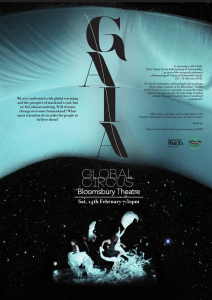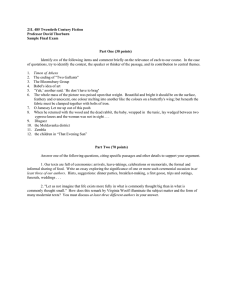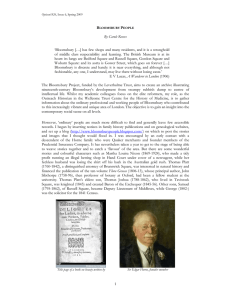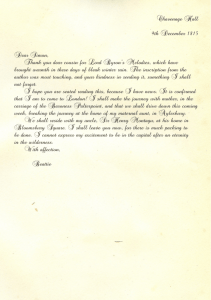Aerodiphros Inventors’ I’m going to talk in particular about two of Bloomsbury’s...
advertisement
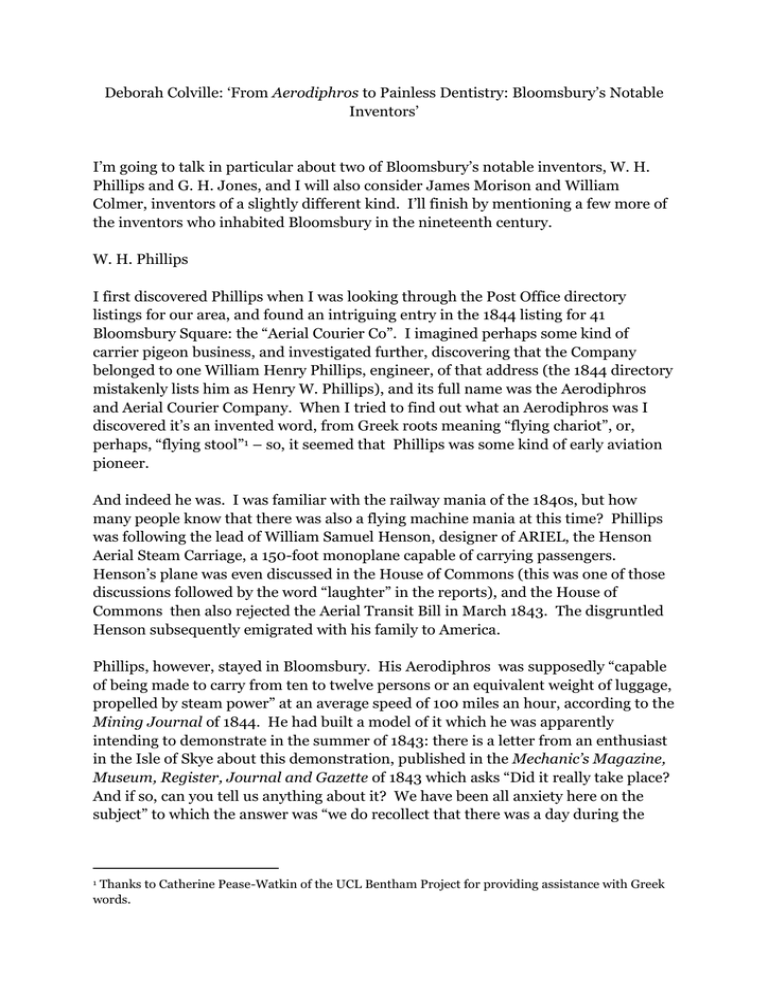
Deborah Colville: ‘From Aerodiphros to Painless Dentistry: Bloomsbury’s Notable Inventors’ I’m going to talk in particular about two of Bloomsbury’s notable inventors, W. H. Phillips and G. H. Jones, and I will also consider James Morison and William Colmer, inventors of a slightly different kind. I’ll finish by mentioning a few more of the inventors who inhabited Bloomsbury in the nineteenth century. W. H. Phillips I first discovered Phillips when I was looking through the Post Office directory listings for our area, and found an intriguing entry in the 1844 listing for 41 Bloomsbury Square: the “Aerial Courier Co”. I imagined perhaps some kind of carrier pigeon business, and investigated further, discovering that the Company belonged to one William Henry Phillips, engineer, of that address (the 1844 directory mistakenly lists him as Henry W. Phillips), and its full name was the Aerodiphros and Aerial Courier Company. When I tried to find out what an Aerodiphros was I discovered it’s an invented word, from Greek roots meaning “flying chariot”, or, perhaps, “flying stool”1 – so, it seemed that Phillips was some kind of early aviation pioneer. And indeed he was. I was familiar with the railway mania of the 1840s, but how many people know that there was also a flying machine mania at this time? Phillips was following the lead of William Samuel Henson, designer of ARIEL, the Henson Aerial Steam Carriage, a 150-foot monoplane capable of carrying passengers. Henson’s plane was even discussed in the House of Commons (this was one of those discussions followed by the word “laughter” in the reports), and the House of Commons then also rejected the Aerial Transit Bill in March 1843. The disgruntled Henson subsequently emigrated with his family to America. Phillips, however, stayed in Bloomsbury. His Aerodiphros was supposedly “capable of being made to carry from ten to twelve persons or an equivalent weight of luggage, propelled by steam power” at an average speed of 100 miles an hour, according to the Mining Journal of 1844. He had built a model of it which he was apparently intending to demonstrate in the summer of 1843: there is a letter from an enthusiast in the Isle of Skye about this demonstration, published in the Mechanic’s Magazine, Museum, Register, Journal and Gazette of 1843 which asks “Did it really take place? And if so, can you tell us anything about it? We have been all anxiety here on the subject” to which the answer was “we do recollect that there was a day during the Thanks to Catherine Pease-Watkin of the UCL Bentham Project for providing assistance with Greek words. 1 present summer on which Mr Phillips promised, by public advertisement, to make an ‘actual transit or flight’, but (unfortunately) failed to perform his promise”. So who was Phillips? He hadn’t been in Bloomsbury Square very long by 1844. He was previously at 80 High Holborn, from where, in 1840, he was advertising as a “pneumatician” (The Times, 16 March and 19 May 1840). This splendid-sounding job title is explained in more detail in the advertisements, which begin “Smoky Chimnies Cured at Once”. He then moved to Bloomsbury Square, as a further advertisement shows: “Smoky Chimneys perfectly Cured, by one simple operation, at a moderate charge...W. H. Phillips and Co beg to announce that their time is entirely devoted to the correction of chimneys smoking into rooms...from any cause whatever. The charge to effect this permanent cure is from £1 to £2, including all expenses...No charge for inspection within five miles of London” (The Times, 27 January 1844) By 1853, he seems to have been on a downward spiral: The Times reports that he caused a disturbance in the offices of the Fire Annihilator company in Leadenhall Street. He had taken out the patent for the Fire Annihilator and had been connected with the company, but he apparently now wished not to be associated with it any more, and had turned up at the company’s offices and started tearing up their prospectuses. He was bound over to keep the peace for six months. (The Times, 24 August 1853) His name was continuing to appear in advertisements for the company in September 1853 (The Times, 17 September 1853). This was not the end of his career as an inventor, though. In 1854 he applied for a patent on “improvements in rotatory steam engines” (Mechanics’ Magazine, 1855; application made 4 October 1854) and this was in connection with his continuing work on the Aerodiphros. In fact, his name is quite well known to historians of aviation, because in 1868, it appears that he finally managed to demonstrate his flying machine. This was at the Royal Aeronautical Society’s exhibition, Crystal Palace, June 1868, the world’s first aeronautical exhibition, and one which included trials of various aerial machines (The Times, 23 and 24 June 1868). According to Phillips’s own notes, this was one of several successful flights his model had made: “The steam was up in a few seconds, when the whole apparatus spun around like a top and mounted into the air faster than any bird; to what height it ascended I had no means of ascertaining. The distance travelled was across two fields where, after a long search, I found the machine minus the wings, which had been torn off from contact with the ground”. (quoted in www.aviastar.org/history/index.html) It was based on a system of jet propulsion – steam squirted out of openings in the arm of the rotor, spinning them around and thus lifting the machine into the sky. This was the first time that a model helicopter powered by an actual engine, rather than a stored energy device such as coiled springs, had successfully been flown. One aviation historian comments “When news of the model rotary wing airplane circulated among scientific groups, it was considered nothing short of sensational. Some engineers became overly enthusiastic about Phillips’ flying machine, and soon there was talk of building large passenger-carrying helicopters. These bold ideas quickly faded when it was realized that a much more suitable power unit other than the bulky steam engine would be needed before their dreams could become a reality” (www.aviastar.org/history/index.html) G. H. Jones From steam-powered helicopters to painless dentistry – and Mr George Horatio Jones, of Great Russell Street. He was born in Cork, Ireland, around 1844, but had moved to England by the time he was 18, when the 1861 census shows him in Devon, pupil of Alfred Huston, surgeon dentist. By April 1871 (the time of the 1871 census) he was living with his wife Annie at 57 Great Russell Street, and this was to remain both his home and his professional address for several decades. His advertisements are very prominent in The Times during the 1870s and 1880s, usually headed by the promise “Painless Dentistry”. This kind of advertisement was of course very common in the late nineteenth century, but something relatively unusual about Jones’s promises of painless dentistry was that he wasn’t just talking about the use of nitrous oxide in his practice. (As we know, the first use of ether as an anaesthetic in Britain had been carried out in Bloomsbury, in Gower Street in 1846 by a dentist, James Robinson.) G. H. Jones was interested in extending the painlessness of dentistry to his main area of interest, false teeth. It was in this connection that he took out a patent on 30 October 1875 for a gadget designed for “painlessly adapting artificial teeth by atmospheric pressure” – the painless part presumablybeing necessary not because the teeth were adapted while you were actually wearing them, but because his greater precision in manufacturing and fitting these dentures made them less painful to wear. His advertisements boasted of the medals he had won in Europe and America in the 1850s and 1860s for his “perfect painless system of adapting Artificial Teeth”, and he also used an endorsement from the royal surgeon dentist “Your teeth are the best, safest, and most life like, and your system is the perfection of painless dentistry” (1915 POD). In 1885 he published a book called Painless and Perfect Dentistry. He also took out at least one patent in America – including one for a lathe for dental surgery, patented 7 October 1879. We can see what this looked like, from a model of it which is still in existence. Under US law, applicants for US patents had to submit a working model of the invention, no more than 12in square, together with explanatory paperwork and diagrams.2 This requirement was not abolished until 1880, the year after Jones applied for his patent, after there had been several fires and it was becoming more and more difficult to store the hundreds of thousands of models 2 US Patent Act, 1790. which had by that stage been accumulated. Some of the models ended up in the Smithsonian but the rest, including Phillips’s lathe, were sold at auction at 1925 – to Henry Wellcome!3 This was not Jones’s only connection with America. In the early 1880s he was actually studying in America at the Baltimore College of Dental Surgery – the first school of dentistry in the world. He graduated in 1883. The archivist of its museum says they don’t have any of his equipment, nor do the records give any clue as to why he went out to America to study; perhaps it was simply what he considered to be necessary professional development which he couldn’t get in Bloomsbury. His career also seems to have had its ups and downs. In 1897 his bankruptcy was reported in The Times (25 September 1897), and one of his patents expired in 1910 because he failed to pay the renewal fee. His financial problems cannot have been too great, though, because he was still advertising his practice in Great Russell Street in the twentieth century – right up to 1929, in fact, so he must have been both extraordinarily long-lived and committed to his career. He also had a rather surprising secondary interest in military technology; he was the author of a privatelycirculated paper on An Improved Torpedo Guard for Ships of War in 1893, and it was an 1899 patent on defences against torpedoes which expired in 1910 when he failed to pay the renewal fee. The First World War seems to have reinvigorated his enthusiasm for military technology, as in 1919 he took out further patents on exploding projectiles and shell or like fuses. Just what you want in a dentist! G. H. Jones remains quite mysterious despite my best efforts to research his life; this is partly because Jones is such a common name. I have not been able to establish much about his origins, and there are also some curious features about his family. His first wife having apparently died within a few years of their marriage in 1870, he married again in 1875. There was one son from the first marriage, and a daughter and three sons from the second marriage. I’ve established pretty well beyond a reasonable doubt that his son Leopold Aloysius Jones (b. 1879) transformed himself in the 1920s into the author and journalist Mark Channing, although this identification was not made in Channing’s obituary in The Times (23 December 1943) and I have not yet found a source which gives Channing’s real identity. (Channing was an author who gave up medical studies at Guy’s to fight in the Boer War, and subsequently served for more than 20 years with the Indian Army, leaving in 1920 to become a journalist and author.) I’ve also been able to establish that another son, listed in the 1891 census Ronald Langton Jones (b. 1884), transformed himself into the distinguished sailor Ronald Langton–Jones, DSO, Battle of Jutland, subsequently Inspector of Lighthouses in the The collection was broken up on his death, but some were eventually (in 1990) acquired by Alan Rothschild, who founded the Rothschild Peterson Patent Model Museum in Cazenovia, New York, in 1998 (www.patentmodel.org). 3 Bahamas! He married the eldest daughter of the Rt Hon. Lord Inverforth, and became quite a prominent public figure, but again his obituary (The Times, 10 January 1967) does not say anything of his origins. And the only daughter of G. H. Jones, Dora Mary Jones (b. 1889) seems to have been devoted to this naval brother and followed him to the Bahamas – she also changed her name to Dora LangtonJones. We can trace these children back to the father of painless dentistry, G. H. Jones, and perhaps we might be able to track down some surviving descendants by appealing on the blog4. There does not seem to have been any obvious discreditable reason for the changes of name. Some of Bloomsbury’s inventors were, however, exactly the kind of people you might want to disown if they appeared in your family tree. The most notable among these is James Morison, the famous inventor of Morison’s Pill. Morison is also one of the best-chronicled of Bloomsbury’s inventors, largely because his Pill caught the imagination of contemporary authors and artists, as well as becoming one of the most contentious products in the keenly-contested battle to establish the idea of “proper” medicine in the nineteenth century.5 Morison was a Scot born into a rich family in 1770, who was educated in Aberdeen and at Hanau in Germany. From the age of sixteen, and for the next thirty-five years, he was a chronic and obsessive hypochondriac, who travelled the world trying to find a cure for all the diseases from which he was convinced he was suffering: until the 1820s, when he had a breakthrough while he was back in Aberdeen – he made his own pill and it worked (according to his own account – I will spare you the grisly details!) It was an ongoing cure; he had to take a few pills every day to stay well, but it was a turning-point in his life. He was convinced that he had found a genuine cure-all – and he came to Bloomsbury to make something of it. What happened after that is well documented; the pills became famous in the 1830s and were commented on satirically by Dickens and Carlyle, among others. The pills were also a natural target for caricaturists, and the Wellcome has a fine set of examples of how Morison’s product was lampooned by Cruikshank and others (show examples). All this publicity probably helped Morison’s sales enormously; his ODNB entry reckons he had a turnover of £100,000 in the 1830s. Before we get too carried away by the gullibility of the public, though, it should be remembered that Morison originally actually gave his pills away – but this was not a success, as apparently people only appreciated them if they were sold. Morison’s first base in London was in Frith Street, Soho, and from there he moved to Claremont Place (which we now know as the eastern end of Bidborough Street, in Mark Channing had a daughter Anna, who married Rodney Grant Lawrence Phillips in 1942; they may have had children. 5 For Morison and the British College of Health, see Shirley Neale, ‘Quackery at King’s Cross: James Morison and the British College of Health’, in Camden History Review, vol. XXVIII (2004) 4 Bloomsbury). But his most enduring and famous location was the purpose-built British College of Health of 1828, in Hamilton Place, New Road (ie the part of Euston Road opposite St Pancras station). The name was significant. Morison had become convinced by this time that the entire medical profession had got everything wrong, and that what was needed was a completely new approach to the body. His Hygeian Theory was based on the importance of purging the blood, which he held responsible for diffusing bad humours all around the body. He started a journal, the Hygeist, to publicise these ideas and, of course, to advertise his Pill. The business survived several setbacks in the 1830s, including vigorous campaigns against Morison by Thomas Wakley, surgeon, founder of the Lancet, and Bedford Square resident, among others; the death of Morison’s business partner, Thomas Moat, allegedly from taking the medicine himself, and several unfavourable inquest verdicts of manslaughter caused by an overdose of Morison’s pills. Morison was not found guilty himself in any of these cases: his pills were sold by agents, and it was the agents who were found liable. Morison paid their fines and court costs. Morison was thoroughly outside the medical system; chemists and druggists did not sell his product until after his death, and before that time it could only be sold by his authorised agents: grocers, stationers, and circulating libraries. (And the clergy were apparently allowed to give it away.) The business also survived vigorous competition from imitators using a variant of the name to try to pass off their pills as the real Morison’s pills; Morison had to advertise in The Times to warn would-be customers of these charlatans (The Times, 20 April 1838) Morison’s death in 1840 also did nothing to slow down the progress of the firm, which was still trading in patent medicines into the 1920s. One of his sons continued his father’s campaign against the medical establishment; John Morison was involved in the anti-vaccination campaigns of the 1870s – this having become in its turn the disputed territory of medicine at this time. Another, the only surviving son of his second marriage, James Augustus Cotter Morison, took little interest in the family business but was a Positivist, a non-religious religion based at this time in Bloomsbury, at the ‘Church of Humanity’ in Chapel Street (Rugby Street). Morison was ironically the most financially successful of these Bloomsbury inventors, although his invention was both the simplest and the most suspect: essentially a laxative promising its takers a cure for all their problems, medical and otherwise (bashfulness, insanity, and ringworm are on the list of things it would supposedly cure). His exploitation of the market from his Bloomsbury base has not been as extensively researched as his life and career as a purveyor of patent medicines in a postwar economic boom. But he was also in the right place at this right time. His pill factory’s position on the Euston Road put a building physically labelled the British College of Health in an area which for the next eighty years was increasingly dominated by medical institutions and colleges – lending his institution a respectability it certainly didn’t deserve. James Colmer was a man who also profited from the creative use of his Bloomsbury location. He was a printer, who had been the printer for the Blind Indigent Visiting Society, a charity founded in 1834 by Lord Shaftesbury. There seems to have been some kind of dispute, which ended up in court, when Colmer alleged malaversion of funds by the Blind Indigent Visiting Society. They prosecuted him for libel, along with his brother, William Colmer, who it was said had the same name as the Secretary of the Blind Indigent Visiting Society. The reports in The Times are understandably confused. This was in 1879, and at the same time, apparently, James Colmer was running his own charity, the Blind Poor Relief Society, also known as the Indigent Poor Relief Society, from two Bloomsbury addresses, 48 Hunter Street and 253 Gray’s Inn Road. The Charity Organisation Society subsequently carried out an investigation into this “charity”, as well as the two other organisations Colmer was apparently running from the same addresses: the London Society for the Employment of Necessitous Gentlewomen, and the Ladies’ Printing Press and Home. They decided that these were entirely spurious, and issued a warning to people who received requests for money from them not to send any. In the late nineteenth century, and into the twentieth, the Charity Organisation Society was often the only authoritative source about the legitimacy or otherwise of a charity; archives are full of letters from wouldbe donors, enclosing appeals from various charitable-sounding organisations, and asking whether these are worthy causes or not. Bloomsbury was the perfect camouflage for institutions with plausible-sounding names, as you can see from the index of institutions on our website. Bloomsbury had more than its fair share of inventors in the nineteenth century, it seems, just as it had an unusually high concentration of educational, medical, charitable, and socially-progressive institutions, and many of them seem to have been based in Great Russell Street and Bloomsbury Square, including Elliott Cresson, of 86 Bloomsbury Square, creator of innovative designs for viaducts and aqueducts for the Pennsylvania Railroad Co, W. Callaghan, of 45 Great Russell Street, creator of an improved deer-stalking telescope, and John Coope Haddan, of 29 Bloomsbury Square, patent agent and civil engineer, who invented various railway carriage improvements and other more military devices relating to projectiles, cannons, and screw propellers. Two other inventors I would like to mention briefly are were both pioneers in the field of photography. J. H. Dallmeyer, born in Westphalia, founded his company J. H. Dallmeyer Ltd in 1859 at 19 Bloomsbury Street; it stayed there until 1888 (and only went out of business in 1993). He developed lenses which were good enough for astronomical observations and taking photographs of the sun, as well as lenses for use in microscopes (David Stone, entry on J. H. Dallmeyer Ltd, in Encyclopaedia of Nineteenth-Century Photography, ed. John Hannay, 2008) And Frederick Scott Archer, of 105 Great Russell Street, invented a collodion process which became the dominant form of photography worldwide from the 1850s to the 1880s and which he thought of calling the “Archerotype”. But he was too unassuming to patent the process and died in poverty in 1857. His children were granted a £50 civil list pension because his discovery was reckoned to have saved about £30,000 in the production of Ordnance Survey maps alone! (Encyclopaedia of Nineteenth-Century Photography, ed. John Hannay, 2008) Bloomsbury was a natural home for inventors of all kinds in the nineteenth century, some of whom are more famous than others. But even those who have been welldocumented, or who are at least well-known to historians working in a particular field like aviation history or photography, have not generally been seen in their Bloomsbury context. We are in the privileged position of being able to see them in their geographical as well as their historical context. Bloomsbury’s preponderance of institutions gave them everything from scientific support and intellectual credibility to a ready market and protective camouflage. And they certainly made the most of it!
